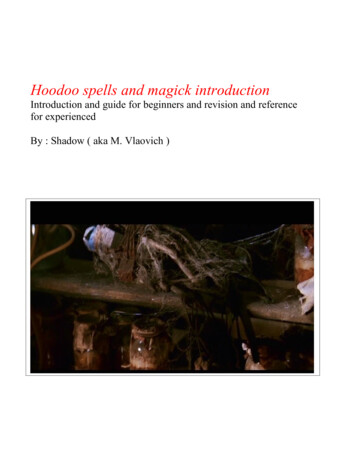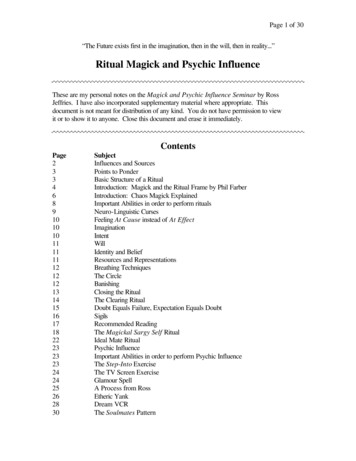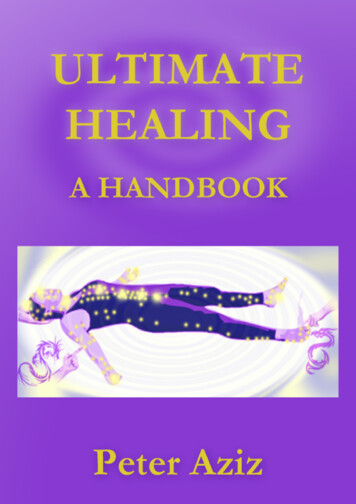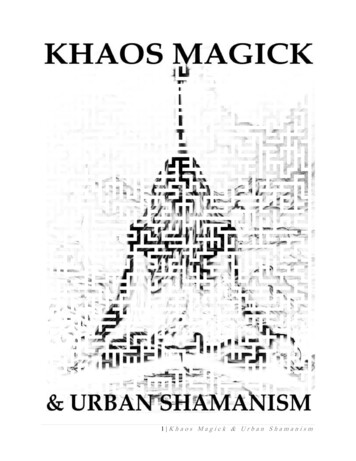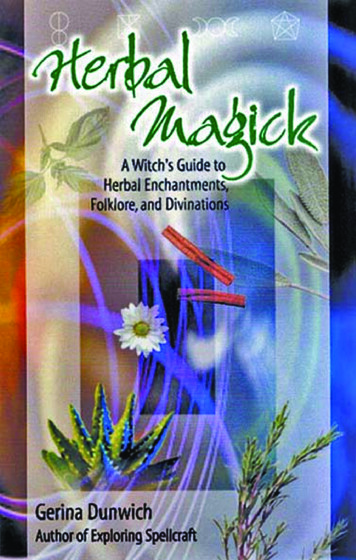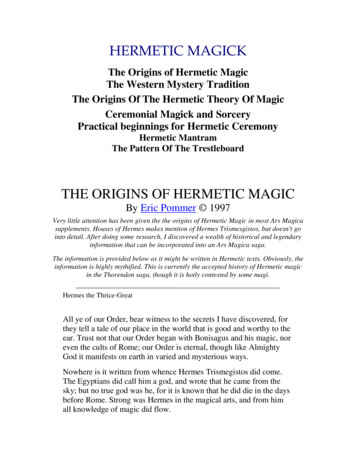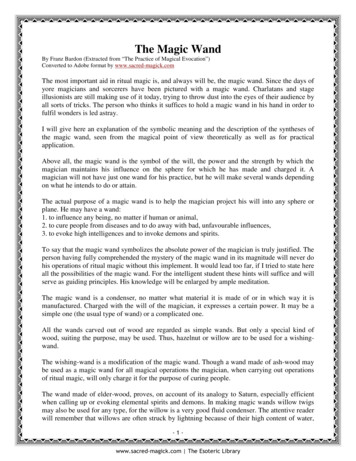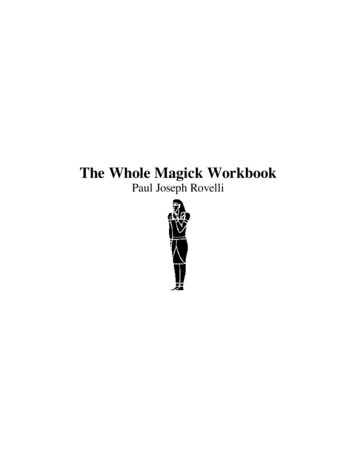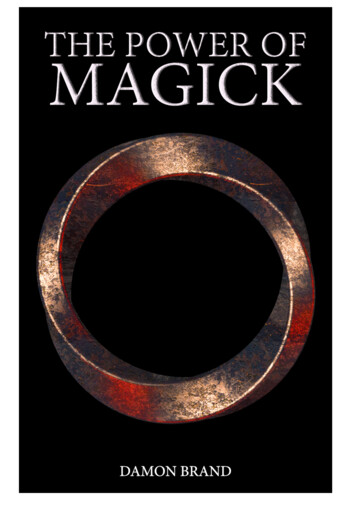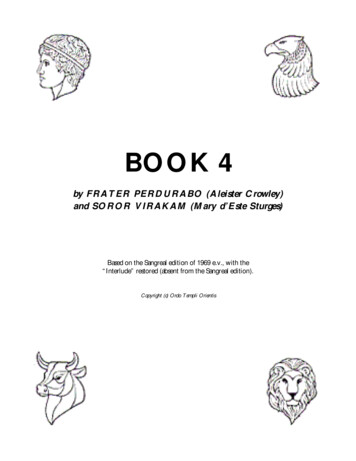
Transcription
BOOK 4by FRATER PERDURABO (Aleister Crowley)and SOROR VIRAKAM (Mary d’Este Sturges)Based on the Sangreal edition of 1969 e.v., with the“Interlude” restored (absent from the Sangreal edition).Copyright (c) Ordo Templi Orientis
THERE are seven keys to the great gate,Being eight in one and one in eight.First, let the body of thee be still,Bound by the cerements of will,Corpse-rigid; thus thou mayst abortThe fidget-babes that tease the thought.Next, let the breath-rhythm be low,Easy, regular, and slow;So that thy being be in tuneWith the great sea’s Pacific swoon.Third, let thy life be pure and calm,Swayed softly as a windless palm.Fourth, let the will-to-live be boundTo the one love of the profound.Fifth, let the thought, divinely freeFrom sense, observe its entity.Watch every thought that springs; enhanceHour after hour thy vigilance!Intense and keen, turned inward, missNo atom of analysis!Sixth, on one thought securely pinnedStill every whisper of the wind!So like a flame straight and unstirredBurn up thy being in one word!Next, still that ecstasy, prolongThy meditation steep and strong,Slaying even God, should He distractThy attention from the chosen act!Last, all these things in one o’erpowered,Time that the midnight blossom flowered!The oneness is. Yet even in this,My son, thou shall not do amissIf thou restrain the expression, shootThy glance to rapture’s darkling root,Discarding name, form, sight, and stressEven of this high consciousness;Pierce to the heart! I leave thee here:Thou art the Master. I revereThy radiance that rolls afar,O Brother of the Silver Star!CROWLEY “AHA!”
Book Fourby Frater Perdurabo and Soror VirakamPART IIMAGICKPRELIMINARY REMARKSIssued by order ofthe GREAT WHITEBROTHERHOODknown as the A.’.A.’.Witness our Seal,N.’.’Praemonstrator-General.
CEREMONIAL MAGICK,footnote: The old spelling MAGICK has been adopted throughout in order to distinguish the Science of the Magifrom all its counterfeits.THE TRAINING FOR MEDITATIONPRELIMINARY REMARKSHITHERTO we have spoken only of the mystic path; and we have kept particularly to the practical exotericside of it. Such difficulties as we have mentioned have been purely natural obstacles. For example, the greatquestion of the surrender of the self, which bulks so largely in most mystical treatises, has not been referred toat all. We have said only what a man must do; we have not considered at all what that doing may involve. Therebellion of the will against the terrible discipline of meditation has not been discussed; one may now devotea few words to it.There is no limit to what theologians call “wickedness.” Only by experience can the student discover theingenuity of the mind in trying to escape from control. He is perfectly safe so long as he sticks to meditation,doing no more and no less than that which we have prescribed; but the mind will probably not let him remainin that simplicity. This fact is the root of all the legends about the “Saint” being tempted by the ‘“Devil.”Consider the parable of Christ in the Wilderness, where he is tempted to use his magical power, to doanything but the thing that should be done. These attacks on the will are as bad as the thoughts which intrudeupon Dharana. It would almost seem as if one could not succesfully practice meditation until the will hadbecome so strong that no force in the Universe could either bend or break it. Before concentrating the lowerprinciple, the mind, one must concentrate the higher principle, the Will. Failure to understand this has destroyedthe value of all attempts to teach “Yoga,” “Menticulture,” “New Thought,” and the like.There are methods of training the will, by which it is easy to check one’s progress.Every one knows the force of habit. Every one knows that if you keep on acting in a particular way, thataction becomes easier, and at last absolutely natural.All religions have devised practices for this purpose. If you keep on praying with your lips long enough, youwill one day find yourself praying in your heart.The whole question has been threshed out and organized by wise men of old; they have made a Science of Lifecomplete and perfect; and they have given to it the name of MAGICK. It is the chief secret of the Ancients,and if the keys have never been actually lost, they have certainly been little used.footnote: The holders of those keys have always kept very quiet about it. This has been especially necessary inEurope, because of the dominance of persecuting churches.Again, the confusion of thought caused by the ignorance of the people who did not understand it has discreditedthe whole subject. It is now our task to re-establish this science in its perfection.To do this we must criticize the Authorities; some of them have made it too complex, others have completelyfailed in such simple matters as coherence. Many of the writers are empirics, still more mere scribes, while byfar the largest class of all is composed of stupid charlatans.
We shall consider a simple form of magick, harmonized from many systems old and new, describing thevarious weapons of the Magician and the furniture of his temple. We shall explain to what each reallycorresponds, and discuss the construction and the use of everything.The Magician works in a Temple; the Universe, which is (be it remembered!) conterminous with himself.footnote: By “yourself” you mean the contents of your consciousness. All without does not exist for you.In this temple a Circle is drawn upon the floor for the limitation of his working. This circle is protected bydivine names, the influences on which he relies to keep out hostile thoughts. Within the circle stands an Altar,the solid basis on which he works, the foundation of all. Upon the Altar are his Wand, Cup, Sword, andPantacle, to represent his Will, his Understanding, his Reason, and the lower parts of his being, respectively.On the Altar, too, is a phial of Oil, surrounded by a Scourge, a Dagger, and a Chain, while above the Altar hangsa Lamp. The Magician wears a Crown, a single Robe, and a Lamen, and he bears a Book of Conjurations and aBell.The oil consecrates everything that is touched with it; it is his aspiration; all acts performed in accordance withthat are holy. The scourge tortures him; the dagger wounds him; the chain binds him. It is by virtue of thesethree that his aspiration remains pure, and is able to consecrate all other things. He wears a crown to affirm hislordship, his divinity; a robe to symbolize silence, and a lamen to declare his work. The book of spells orconjurations is his magical record, his Karma. In the East is the Magick Fire, in which all burns up at last.footnote: He needs nothing else but the apparatus here described for invocation, by which he calls down that whichis above him and within him; but for evocations, by which he calls forth that which is below him and without him,he may place a triangle without the circle.We will now consider each of these matters in detail.
CHAPTER ITHE TEMPLETHE Temple represents the external Universe. The Magician must take it as he finds it, so that it is of noparticular shape; yet we find written, Liber VII, vi, 2: “We made us a Temple of stones in the shape of theUniverse, even as thou didst wear openly and I concealed.” This shape is the Vesica Piscis; but it is only thegreatest of the Magicians who can thus fashion the Temple. There may, however, be some choice of rooms;this refers to the power of the Magician to reincarnate in a suitable body.
CHAPTER IITHE CIRCLETHE Circle announces the Nature of the Great Work.Though the Magician has been limited in his choice of room, he is more or less able to choose what part of theroom he will work in. He will consider convenience and possibility. His circle should not be too small andcramp his movements; it should not be so large that he has long distances to traverse. Once the circle is madeand consecrated, the Magician must not leave it, or even lean outside, lest he be destroyed by the hostileforces that are without.He chooses a circle rather than any other lineal figure for many reasons; e.g.,1. He affirms thereby his identity with the infinite.2. He affirms the equal balance of his working; since all points on the circumference are equidistant from thecentre.3. He affirms the limitation implied by his devotion to the Great Work. He no longer wanders about aimlesslyin the world.The centre of this circle is the centre of the Tau of ten squares which is in the midst, as shown in the illustration.The Tau and the circle together make one form of the Rosy Cross, the uniting of subject and object which isthe Great Work, and which is symbolized sometimes as this cross and circle, sometimes as the Lingam-Yoni,sometimes as the Ankh or Crux Ansata, sometimes by the Spire and Nave of a church or temple, and sometimesas a marriage feast, mystic marriage, spiritual marriage, “chymical nuptials,” and in a hundred other ways.Whatever the form chosen, it is the symbol of the Great Work.This place of his working therefore declares the nature and object of the Work. Those persons who havesupposed that the use of these symbols implied worship of the generative organs, merely attributed to thesages of every time and country minds of a calibre equal to their own.The Tau is composed of ten squares for the ten Sephiroth.footnote: The Ten Sephiroth are the Ten Units. In one system of classification (see “777”) these are so arranged,and various ideas are so attributed to them, that they have been made to mean anything. The more you know, themore these numbers mean to you.About this Tau is escribed a triangle, which is inscribed in the great Circle; but of the triangle nothing isactually marked but the three corners, the areas defined by the cutting of the lines bounding this triangle. Thistriangle is only visible in the parts which are common to two of the sides; they have therefore the shape of thediamond, one form of the Yoni. The significance of this is too complex for our simple treatise; it may bestudied in Crowley’s “Berashith.”The size of the whole figure is determined by the size of one square of the Tau. And the size of this square isthat of the base of the Altar, which is placed upon Maukuth. It will follow then that, in spite of the apparentfreedom of the Magician to do anything he likes, he is really determined absolutely; for as the Altar must havea base proportionate to its height, and as that height must be convenient for the Magician, the size of thewhole will depend upon his own stature. It is easy to draw a moral lesson from these considerations. We will
merely indicate this one, that the scope of any man’s work depends upon his own original genius. Even thesize of the weapons must be determined by necessary proportion. The exceptions to this rule are the Lamp,which hangs from the roof, above the centre of the Circle, above the square of Tiphereth; and the Oil, whosephial is so small that it will suit any altar.On the Circle are inscribed the Names of God; the Circle is of green, and the names are in flaming vermilion,of the same colour as the Tau. Without the Circle are nine pentagrams equidistant,footnote: Some magicians prefer seven lamps, for the seven Spirits of God that are before the Throne. Each standsin a heptagram, and in each angle of the heptagram is a letter, so that the seven names (see “Equinox VII”) arespelt out. But this is a rather different symbolism. Of course in ordinary specialised working the number of lampsdepends on the nature of the work, “e.g.,” three for works of Saturn, eight for works Mercuial, and so on.in the centre of each of which burns a small Lamp; these are the “Fortresses upon the Frontiers of the Abyss.”See the eleventh Aethyr, Liber 418 (“Equinox V”). They keep off those forces of darkness which mightotherwise break in.The names of God form a further protection. The Magician may consider what names he will use; but eachname should in some way symbolise this Work in its method and accomplishment. It is impossible here toenter into this subject fully; the discovery or construction of suitable names might occupy the most learnedQabalist for many years.These nine lamps were originally candles made of human fat, the fat of enemiesfootnote: Or sometimes of “birth-strangled babes,” “i.e.,” of thoughts slain ere they could arise into consciousness.slain by the Magician; they thus served as warnings to any hostile force of what might be expected if it causedtrouble. To-day such candles are difficult to procure; and it is perhaps simpler to use beeswax. The honey hasbeen taken by the Magician; nothing is left of the toil of all those hosts of bees but the mere shell, the fuel oflight. This beeswax is also used in the construction of the Pantacle, and this forms a link between the twosymbols. The Pantacle is the food of the Magus; and some of it he gives up in order to give light to that whichis without. For these lights are only apparently hostile to intrusion; they serve to illuminate the Circle and theNames of God, and so to bring the first and outmost symbols of initiation within the view of the profane.These candles stand upon pentagrams, which symbolize Geburah, severity, and give protection; but alsorepresent the microcosm, the four elements crowned by Spirit, the Will of man perfected in its aspiration tothe Higher. They are placed outside the Circle to attract the hostile forces, to give them the first inkling of theGreat Work, which they too must some day perform.
CHAPTER IIITHE ALTARTHE Altar represents the solid basis of the work, the fixed Willfootnote: It represents the extension of Will. Will is the Dyad (see section on the Wand); 2 x 2 4. So the altaris foursquare, and also its ten squares show 4. 10 1 2 3 4.of the Magician; and the law under which he works. Within this altar everything is kept, since everything issubject to law. Except the lamp.According to some authorities the Altar should be made of oak to represent the stubbornness and rigidity oflaw; others would make it of Acacia, for Acacia is the symbol of resurrection.The Altar is a double cube, which is a rough way of symbolizing the Great Work; for the doubling of the cube,like the squaring of the circle, was one of the great problems of antiquity. The surface of this Altar is composedof ten squares. The top is Kether, and the bottom Malkuth. The height of the Altar is equal to the heightabove the ground of the navel of the Magician. The Altar is connected with the Ark of the Covenant, Noah’sArk, the nave (“navis,” a ship) of the Church, and many other symbols of antiquity, whose symbolism hasbeen well worked out in an anonymous book called “The Cannon,”WEH footnote: written by William Stirling(Elkin Mathews), which should be studied carefully before constructing the Altar.For this Altar must embody the Magician’s knowledge of the laws of Nature, which are the laws throughwhich he works.He should endeavour to make geometrical constructions to symbolize cosmic measurements. For example,he may take the two diagonals as (say) the diameter of the sun. Then the side of the altar will be found to havea length equal to some other cosmic measure, a vesica drawn on the side some other, a “rood cross” within thevesica yet another. Each Magician should work out his own system of symbolism — and he need not confinehimself to cosmic measurements. He might, for example, find some relation to express the law of inversesquares.The top of the Altar shall be covered with gold, and on this gold should be engraved some such figure as theHoly Oblation, or the New Jerusalem, or, if he have the skill, the Microcosm of Vitruvius, of which we giveillustrations.On the sides of the Altar are also sometimes drawn the great tablets of the elements, and the sigils of the holyelemental kings, as shown in The Equinox, No. VII; for these are syntheses of the forces of Nature. Yet theseare rather special than general symbols, and this book purports to treat only of the grand principles of working.
CHAPTER IVTHE SCOURGE, THE DAGGER, AND THE CHAINTHE Scourge, the Dagger, and the Chain, represent the three alchemical principles of Sulphur, Mercury, andSalt. These are not the substances which we now call by these names; they represent “principles,” whoseoperations chemists have found it more convenient to explain in other ways. But Sulphur represents theenergy of things, Mercury their fluidity, Salt their fixity. They are analogous to Fire, Air and Water; but theymean rather more, for they represent something deeper and subtler, and yet more truly active. An almostexact analogy is given by the three Gunas of the Hindus; Sattvas, Rajas, and Tamas. Sattvas is Mercury,equable, calm, clear; Rajas is Sulphur, active, excitable, even fierce; Tamas is Salt, thick, sluggish, heavy, dark.footnote: There is a long description of these three Gunas in the Bhagavadgita.But Hindu philosophy is so occupied with the main idea that only the Absolute is worth anything, that ittends to consider these Gunas (even Sattvas) as evil. This is a correct view, but only from above; and weprefer, if we are truly wise, to avoid this everlasting wail which characterizes the thought of the Indian peninsula:“Everything is sorrow,” etc. Accepting their doctrine of the two phases of the Absolute, we must, if we are tobe consistent, class the two phases together, either as good or as bad; if one is good and the other bad we areback again in that duality, to avoid which we invented the Absolute.The Christian idea that sin was worth while because salvation was so much more worth while, that redemptionis so splendid that innocence was well lost, is more satisfactory. St. Paul says: “Where sin abounded, there didgrace much more abound. Then shall we do evil that good may come? God forbid.” But (clearly!) it is exactlywhat God Himself did, or why did He create Satan with the germ of his “fall” in him?Instead of condemning the three qualities outright, we should consider them as parts of a sacrament. Thisparticular aspect of the Scourge, the Dagger, and the Chain, suggests the sacrament of penance.The Scourge is Sulphur: its application excites our sluggish natures; and it may further be used as an instrumentof correction, to castigate rebellious volitions. It is applied to the Nephesh, the Animal Soul, the naturaldesires.The Dagger is Mercury: it is used to calm too great heat, by the letting of blood; and it is this weapon whichis plunged into the side or heart of the Magician to fill the Holy Cup. Those faculties which come betweenthe appetites and the reason are thus dealt with.The Chain is Salt: it serves to bind the wandering thoughts; and for this reason is placed about the neck of theMagician, where Daath is situated.These instruments also remind us of pain, death, and bondage. Students of the gospel will recollect that in themartyrdom of Christ these three were used, the dagger being replaced by the nails.footnote: This is true of all magical instruments. The Hill of Golgotha is a circle, and the Cross the Tau. Christhad robe, crown, sceptre, etc.; this thesis should one day be fully worked out.The Scourge should be made with a handle of iron; the lash is composed of nine strands of fine copper wire, ineach of which are twisted small pieces of lead. Iron represents severity, copper love, and lead austerity.The Dagger is made of steel inlaid with gold; and the hilt is also golden.
The chain{Sic} is made of soft iron. It has 333 links.footnote: See The Equinox, No. V, “The Vision and the Voice”: Xth Aethyr.It is now evident why these weapons are grouped around the phial of clear crystal in which is kept the HolyOil.The Scourge keeps the aspiration keen: the Dagger expresses the determination to sacrifice all; and the Chainrestricts any wandering.We may now consider the Holy Oil itself.
CHAPTER VTHE HOLY OILTHE Holy Oil is the Aspiration of the Magician; it is that which consecrates him to the performance of theGreat Work; and such is its efficacy that it also consecrates all the furniture of the Temple and the instrumentsthereof. It is also the grace or chrism; for this aspiration is not ambition; it is a quality bestowed from above. Forthis reason the Magician will anoint first the top of his head before proceeding to consecrate the lower centresin their turn.This oil is of a pure golden colour; and when placed upon the skin it should burn and thrill through the bodywith an intensity as of fire. It is the pure light translated into terms of desire. It is not the Will of the Magician,the desire of the lower to reach the higher; but it is that spark of the higher in the Magician which wishes tounite the lower with itself.Unless therefore the Magician be first anointed with this oil, all his work will be wasted and evil.This oil is compounded of four substances. The basis of all is the oil of the olive. The olive is, traditionally, thegift of Minerva, the Wisdom of God, the Logos. In this are dissolved three other oils; oil of myrrh, oil ofcinnamon, oil of galangal. The Myrrh is attributed to Binah, the Great Mother, who is both the understandingof the Magician and that sorrow and compassion which results from the contemplation of the Universe. TheCinnamon represents Tiphereth, the Sun — the Son, in whom Glory and Suffering are identical. The Galangalrepresents both Kether and Malkuth, the First and the Last, the One and the Many, since in this Oil they areOne.These oils taken together represent therefore the whole Tree of Life. The ten Sephiroth are blended into theperfect gold.This Oil cannot be prepared from crude myrrh, cinnamon, and galangal. The attempt to do so only gives abrown mud with which the oil will not mix. These substances must be themselves refined into pure oilsbefore the final combination.This perfect Oil is most penetrating and subtle. Gradually it will spread itself, a glistening film, over everyobject in the Temple. Each of these objects will then flame in the light of the Lamp. This Oil is like thatwhich was in the widow’s curse: it renews and multiplies itself miraculously; its perfume fills the wholeTemple; it is the soul of which the grosser perfume is the body.The phial which contains the Oil should be of clear rock crystal, and some magicians have fashioned it in theshape of the female breast, for that it is the true nourishment of all that lives. For this reason also it has beenmade of mother-of-pearl and stoppered with a ruby.
CHAPTER VITHE WANDTHE Magical Will is in its essence twofold, for it presupposes a beginning and an end; to will to be a thing isto admit that you are not that thing.Hence to will anything but the supreme thing, is to wander still further from it — any will but that to give upthe self to the Beloved is Black Magick — yet this surrender is so simple an act that to our complex minds itis the most difficult of all acts; and hence training is necessary. Further, the Self surrendered must not be lessthan the All-Self; one must not come before the altar of the Most High with an impure or an imperfectoffering. As it is written in Liber LXV, “To await Thee is the end, not the beginning.”This training may lead through all sorts of complications, varying according to the nature of the student, andhence it may be necessary for him at any moment to will all sorts of things which to others might seemunconnected with the goal. Thus it is not “a priori” obvious why a billiard player should need a file.Since, then, we may want “anything,” let us see to it that our will is strong enough to obtain anything wewant without loss of time.It is therefore necessary to develop the will to its highest point, even though the last task but one is the totalsurrender of this will. Partial surrender of an imperfect will is of no account in Magick.The will being a lever, a fulcrum is necessary; this fulcrum is the main aspiration of the student to attain. Allwills which are not dependent upon this principal will are so many leakages; they are like fat to the athlete.The majority of the people in this world are ataxic; they cannot coordinate their mental muscles to make apurposed movement. They have no real will, only a set of wishes, many of which contradict others. Thevictim wobbles from one to the other (and it is no less wobbling because the movements may occasionally bevery violent) and at the end of life the movements cancel each other out. Nothing has been achieved; exceptthe one thing of which the victim is not conscious: the destruction of his own character, the confirming ofindecision. Such an one is torn limb from limb by Choronzon.How then is the will to be trained? All these wishes, whims, caprices, inclinations, tendencies, appetites, mustbe detected, examined, judged by the standard of whether they help or hinder the main purpose, and treatedaccordingly.Vigilance and courage are obviously required. I was about to add self-denial, in deference to conventionalspeech; but how could I call that self-denial which is merely denial of those things which hamper the self? Itis not suicide to kill the germs of malaria in one’s blood.Now there are very great difficulties to be overcome in the training of the mind. Perhaps the greatest isforgetfulness, which is probably the worst form of what the Buddhists call ignorance. Special practices fortraining the memory may be of some use as a preliminary for persons whose memory is naturally poor. In anycase the Magical Record prescribed for Probationers of the A.’.A.’. is useful and necessary.Above all the practices of Liber III must be done again and again, for these practices develop not only vigilancebut those inhibiting centres in the brain which are, according to some psychologists, the mainspring of themechanism by which civilized man has raised himself above the savage.
So far it has been spoken, as it were, in the negative. Aaron’s rod has become a serpent, and swallowed theserpents of the other Magicians; it is now necessary to turn it once more into a rod.footnote: As everyone knows, the word used in Exodus for a Rod of Almond is {{Hebrew letters: Mem-tet-HayHay-Shin-Qof-Dalet}, adding to 463. Now 400 is Tau, the path leading from Malkuth to Yesod. Sixty is Samekh, the path leadingleading {{sic}} from Yesod to Tiphereth; and 3 is Gimel, the path leading thence to Kether. The whole rodtherefore gives the paths from the Kingdom to the Crown.}This Magical Will is the wand in your hand by which the Great Work is accomplished, by which the Daughteris not merely set upon the throne of the Mother, but assumed into the Highest.footnote: In one, the best, system of Magick, the Absolute is called the Crown, God is called the Father, the PureSoul is called the Mother, the Holy Guardian Angel is called the Son, and the Natural Soul is called theDaughter. The Son purifies the Daughter by wedding her; she thus becomes the Mother, the uniting of whomwith the Father absorbs all into the Crown. See Liber CDXVIII.The Magick Wand is thus the principal weapon of the Magus; and the “name” of that wand is the MagicalOath.The will being twofold is in Chokmah, who is the Logos, the word; hence some have said that the word is thewill. Thoth the Lord of Magic {sic} is also the Lord of Speech; Hermes the messenger bears the Caduceus.Word should express will: hence the Mystic Name of the Probationer is the expression of his highest Will.There are, of course, few Probationers who understand themselves sufficiently to be able to formulate this willto themselves, and therefore at the end of their probation they choose a new name.It is convenient therefore for the student to express his will by taking Magical Oaths.Since such an oath is irrevocable it should be well considered; and it is better not to take any oath permanently;because with increase of understanding may come a perception of the incompatibility of the lesser oath withthe greater.This is indeed almost certain to occur, and it must be remembered that as the whole essence of the will is itsone-pointedness,footnote: The Top of the Wand is in Kether — which is one; and the Qliphoth of Kether are the Thaumiel,opposing heads that rend and devour each other.a dilemma of this sort is the worst in which the Magus can find himself.Another great point in this consideration of Magick Vows is to keep them in their proper place. They must betaken for a clearly defined purpose, a clearly understood purpose, and they must never be allowed to gobeyond it.It is a virtue in a diabetic not to eat sugar, but only in reference to his own condition. It is not a virtue ofuniversal import. Elijah said on one occasion: “I do well to be angry;” but such occasions are rare.Moreover, one man’s meat is another man’s poison. An oath of poverty might be very useful for a man whowas unable intelligently to use his wealth for the single end proposed; to another it would be simply stripping
himself of energy, causing him to waste his time over trifles.There is no power which cannot be pressed in to the service of the Magical Will: it is only the temptation tovalue that power for itself which offends.One does not say: “Cut it down; why cumbereth it the ground?” unless repeated prunings have convincedthe gardener that the growth must always be a rank one.“If thine hand offend thee, cut it off!” is the scream of a weakling. If one killed a dog the first time it misbehaveditself, not many would pass the stage of puppyhood.The best vow, and that of most universal application, is the vow of Holy Obedience; for not only does it leadto perfect freedom, but is a training in that surrender which is the last task.WEH footnote: Of all Crowley’s views, this is the most controversial. It appears to fly in the face of Thelema.There is high merit in a vow of obedience, and necessity; but the merit is to be found in the “small print.” Toreceive a vow of obedience from another implies perfection in the teache
Book Four by Frater Perdurabo and Soror Virakam PART II MAGICK PRELIMINARY REMARKS Issued by order of the GREAT WHITE BROTHERHOOD known as the


